Blows of the divine wind
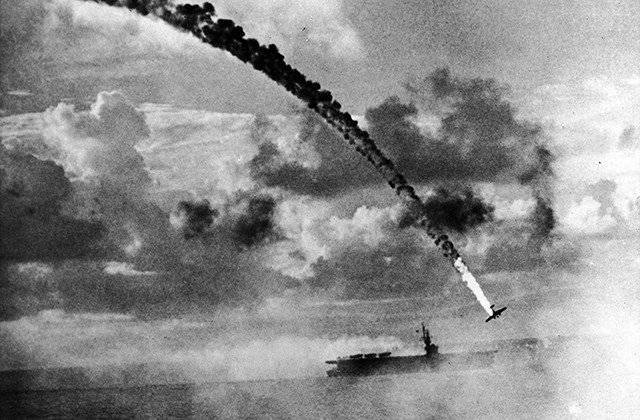
On the morning of October 20, 1944, at the 201st Japanese Airborne Group aviation in the Philippines, a suicide attack unit, the kamikaze, was first formed. The division consisted of four squads of six aircraft each: Yamato (the ancient name of Japan), Asahi (the rising sun - the symbol of Japan), Shikishima (the poetic name of Japan) and Yamasakura (mountain cherry flower).
Kamikaze squad leader, commander of the first air force fleet Vice Admiral Onishi Takijiro stated: “If a pilot, seeing an enemy plane or ship, strains all his will and strength, turns the plane into a part of himself, this is the most perfect weapon. And can there be greater glory for a warrior than to give his life for the emperor and for the country? ”
However, the Japanese command did not come to such a decision from a good life. By October 1944, Japan’s losses in the aircraft, and most importantly, in experienced pilots, were catastrophic. Otherwise, as a gesture of despair and faith in a miracle that can, if not break, even out the balance of power in the Pacific, you cannot call the creation of kamikaze groups. The father of the kamikaze and the corps commander, Vice-Admiral Onisi, and the commander of the combined fleet, Admiral Toyoda, understood perfectly well that the war was already lost. Creating a corps of suicide bombers, they hoped that the damage caused by the kamikaze attacks on the American fleet would allow Japan to avoid unconditional surrender and make peace on relatively acceptable conditions.
Problems with the Japanese command was not only with a set of pilots to perform suicidal tasks. The German Vice-Admiral Helmut Geie once wrote: “It is possible that there are a number of people in our people who not only declare their willingness to voluntarily go to their death, but also find enough mental strength in them to actually do this. But I have always believed and believe that such feats can not be performed by representatives of the white race. It happens, of course, that thousands of courageous people in the heat of battle act without sparing their lives; this undoubtedly often happened in the armies of all countries of the world. But so that this or that person voluntarily condemned himself to certain death in advance — such a form of military use of people is unlikely to become common among our peoples. A European simply does not have that religious fanaticism that would justify such feats, a European is deprived of contempt for death and, consequently, for his own life ... "
The Japanese soldiers, brought up in the spirit of Bushido, the main priority was the implementation of the order, even at the cost of their own lives. The only thing that distinguished the kamikaze from ordinary Japanese soldiers was the almost complete lack of chances to survive the task.
The Japanese expression "kamikaze" is translated as "divine wind" - the Shinto designation of the storm, which benefits or is a favorable sign. This word was called a hurricane, which twice - in 1274 and 1281, defeated a fleet of Mongolian conquerors off the coast of Japan. According to the beliefs of the Japanese, the hurricane was sent by the god of thunder Raidzin and the god of wind Fujin. Actually, thanks to Shintoism, a single Japanese nation was formed, this religion is the basis of Japanese national psychology. According to her, the mikado (emperor) is a descendant of the spirits of heaven, and every Japanese is a descendant of less significant spirits. Therefore, for the Japanese, the emperor, due to his divine origin, is related to all the people, acts as the head of the nation-family and as the main priest of Shintoism. And for every Japanese, it was considered important to be loyal above all to the emperor.
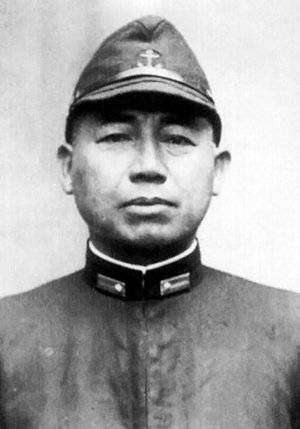
Zen Buddhism also had an undoubted influence on the Japanese character. Zen became the main religion of the samurai, who found in the meditation used by him a way to fully reveal their inner potential.
Confucianism also became widespread in Japan, the principles of submission and unconditional obedience to authority, filial piety found fertile ground in Japanese society.
Shintoism, Buddhism and Confucianism were the basis on which the whole complex of moral and ethical norms was formed, which formed the samurai bushido code. Confucianism provided a moral and ethical rationale for Bushido, Buddhism brought indifference to death, Shintoism formed the Japanese as a nation.
A samurai death wish must be complete. He had no right to fear her, to dream that he would live forever. All thoughts of a warrior, according to Bushido, should be directed to rush into the thick of enemies and die with a smile.
In accordance with traditions, the kamikaze has developed its own special ritual of farewell and special attributes. Kamikaze wore the same uniform as regular pilots. However, on each of her seven buttons three sakura petals were knocked out. At the suggestion of Onishi, white headbands on the forehead, the hatimaki, became the distinctive part of the kamikaze outfit. They often depicted the red sun disk hinomaru, and also deduced black hieroglyphs with patriotic and sometimes mystical statements. The most common inscription was "Seven Lives for the Emperor."
Another tradition was a cup of sake just before the start. Right on the tarmac, the table was covered with a white tablecloth - according to Japanese legends, it is a symbol of death. They filled cups with drink and offered them to each of the pilots who were lined up in a line, departing the flight. Kamikaze took the cup with both hands, bowed low and took a sip.
A tradition has been established, according to which the pilots flying to the last flight were given a bento - a box of food. It contained eight small rice balls called makizushi. These boxes were originally issued to the pilots who went on a long flight. But already in the Philippines they began to supply and kamikazes. Firstly, because their last flight could have been a long one and was required to maintain strength. Secondly, for the pilot, who knew that he would not return from the flight, the box with food served as psychological support.
All the suicide bombers left in special small wooden unpainted boxes of nail clippings and strands of their hair for sending to their families, as each of the Japanese soldiers did.
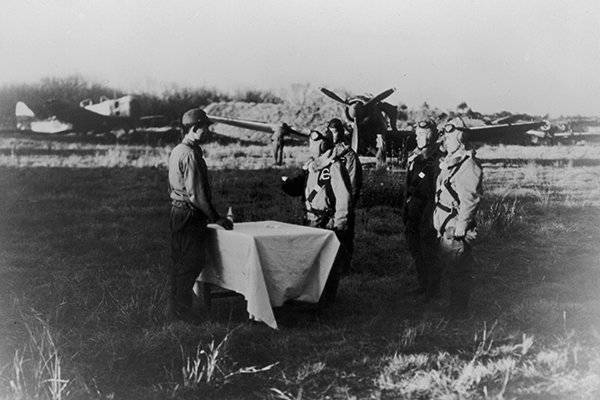
October 25 1944 of the year in Leyte Gulf was the first massive kamikaze attack against enemy aircraft carriers. Having lost the 17 aircraft, the Japanese managed to destroy one and damage six enemy aircraft carriers. It was the undoubted success of the innovative tactics of Onishi Takijiro, especially given the fact that on the eve of the Second Air Fleet of Admiral Fukudome Shigeru he lost 150 aircraft, not having achieved success at all.
Almost simultaneously with naval aviation, the first detachment of army kamikaze pilots was created. It was formed immediately six army units of special attacks. Since there was no shortage of volunteers, and in the opinion of the authorities, there were no failures, the pilots were transferred to the army kamikazes without their consent. November 5 is considered the day of official participation in the hostilities of army groups of suicide pilots all in the same Leyte Gulf.
However, not all Japanese pilots shared such tactics, there were exceptions. On November 11, one of the American destroyers rescued a Japanese kamikaze pilot. The pilot was part of the Second Air Fleet of Admiral Fukudome, redeployed from Formoza 22 October to participate in the operation "Se-Go." He explained that upon arrival in the Philippines there was no talk of suicide attacks. But on October 25, kamikaze groups began to hastily form in the Second Air Fleet. Already on October 27, the squadron commander in which the pilot served, announced to his subordinates that their unit was intended to carry out suicide attacks. The pilot himself considered the very idea of such strikes stupid. He had no intention of dying, and the pilot frankly sincerely admitted that he had never felt the desire to commit suicide.
How was the air kamikaze attack? In the face of increasing losses of bomber aircraft, the idea was born of attacking American ships with fighters alone. The lightweight Zero was not able to lift a heavy powerful bomb or torpedo, but could carry an 250-kilogram bomb. Of course, one such bomb aircraft carrier can not sink, but disable it for a long period was quite real. It is enough to damage the flight deck.
Admiral Onishi concluded that the three kamikaze aircraft and the two escort fighters were a small, and therefore quite mobile and optimal in composition group. Escort fighters played an extremely important role. They had to repel the attacks of the enemy interceptors until the kamikaze planes rushed to the target.
Because of the danger of detection by radars or fighters from aircraft carriers, kamikaze pilots used two methods for reaching the target - flying at extremely low altitudes 10 – 15 meters and at extremely large altitudes - 6 – 7 kilometers. Both methods required proper qualifications of pilots and reliable equipment.
However, in the future, it was necessary to use any aircraft, including outdated and educational ones, and a young and inexperienced recruitment went into the kamikaze pilots, which simply did not have enough time to train.
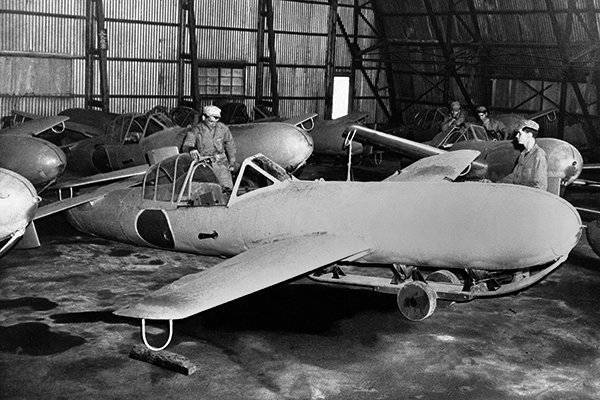
21 March 1945 for the first time made an unsuccessful attempt to use the Yokosuka MXY7 Oka manned aircraft with the “Gods of Thunder” squadron. This aircraft was a rocket engine designed specifically for kamikaze attacks, and was equipped with an 1200-kilogram bomb. During the attack, the Oka projectile flew into the air with the Mitsubishi G4M aircraft until it was within the radius of destruction. After undocking, the pilot in the hovering mode had to bring the plane as close as possible to the target, turn on the rocket engines and then ram the intended ship at great speed. The Allied forces quickly learned to attack the Oka carrier before it could launch a shell plane. The first successful use of the Oka aircraft occurred on April 12, when a shell plane piloted by Doha Saburo, the 22-year-old lieutenant, sank the Mannert L. Abele radar patrol destroyer.
In all, 1944 shells were produced in 1945 – 850 years.
In the waters of Okinawa, suicide pilots have done very serious damage to the US Navy. From 28 ships sunk by aviation, kamikazes were sent to the bottom of 26. 225 damaged kamikaze ships damaged 164, including 27 aircraft carriers and several battleships and cruisers. Four British aircraft carriers received five hits of kamikaze aircraft. About 90, kamikaze percentages did not hit the target or were shot down. Heavy losses suffered corps "Gods of Thunder." Of the 185 Oka planes used for the attacks, 118 was destroyed by the enemy, 438 pilots were killed, including 56 "gods of thunder" and 372 crew member aircraft.
The last ship lost by the United States in the war in the Pacific was the destroyer Callaghan. In the Okinawa area, 29 July 1945, using the night darkness, the old low-speed training biplane "Aichi D2" with the 60-kilogram bomb in 0-41 managed to break through to the "Callaghan" and ram it. The blow fell on the captain's bridge. A fire broke out that led to an explosion of ammunition in the cellar. The crew left the sinking ship. 47 seafarers died, 73 people were injured.
On August 15, Emperor Hirohito, in his radio speech, announced the surrender of Japan. In the evening of the same day, many of the commanders and staff officers of the kamikaze corps went to the last flight. Vice-Admiral OnisiTakidziro on the same day made hara-kiri.
And the last kamikaze attacks were made on Soviet ships. On August 18, a Japanese army twin-engine bomber attempted to ram the Taganrog tanker in the Amur Bay near the Vladivostok oil base, but was shot down by anti-aircraft fire. As follows from the surviving documents, piloted by the aircraft lieutenant Yoshiro Tiohara.
On the same day, the kamikazes achieved their only victory by sinking the minesweeper KT-152 in the Shumshu area (Kuril Islands). The former seiner, the fish scout “Neptune”, was built in 1936 and had a tonnage of 62 and a crew of seamen from 17. From the impact of the Japanese aircraft, the minesweeper immediately went to the bottom.
Naito Hatsaro in his book The Gods of Thunder. Kamikaze pilots tell their stories”(Thundergods. The Kamikaze Pilots Tell Their Story. - NY, 1989, p. 25.) Cites the number of casualties of naval and military kamikazes accurate to man. According to him, 1944 naval and 1945 army pilots were killed in suicide attacks in 2525 – 1388. Thus, 3913 kamikaze pilots were killed in total, and this number did not include lone suicide bombers - those who made their own decisions to go on a suicide attack.
According to Japanese statements, as a result of kamikaze attacks, the 81 ship was sunk, 195 damaged. According to American data, the losses amounted to 34 sunk and 288 damaged ships.
But in addition to material losses from the mass attacks of suicide pilots, the allies received a psychological shock. He was so serious that the commander of the US Pacific Fleet, Admiral Chester Nimitz, suggested keeping secret about the kamikaze attacks. The US military censorship imposed strict restrictions on the dissemination of reports of attacks by suicide pilots. The British allies also did not talk about kamikazes until the end of the war.
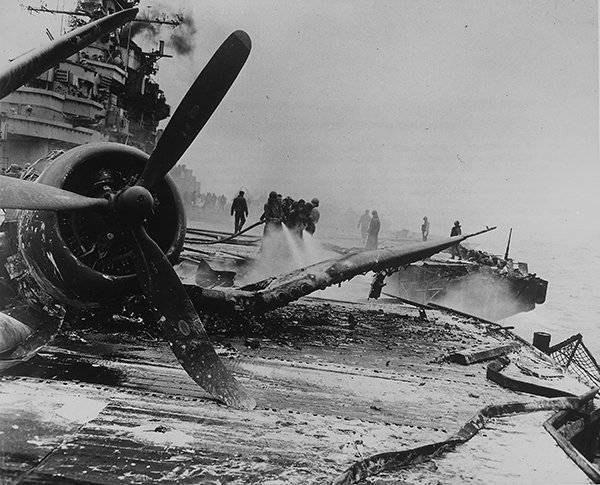
Nonetheless, the kamikaze attacks have admired many. Americans have always been amazed at the morale demonstrated by suicide pilots. The spirit of kamikaze, originating in the depths of Japanese history, illustrated in practice the concept of the power of the spirit over matter. “There was some hypnotizing admiration in this philosophy alien to the West,” Vice-Admiral Brown recalled. “We were fascinated to watch every kamikaze dive — more like the audience in a performance, not the potential victims they were going to kill. For a while we forgot about ourselves and thought only about the person who is on the plane. ”
However, it is worth noting that the first case of an enemy ship ramming an aircraft occurred on August 19 of the year 1937 during the so-called Shanghai incident. And it was produced by a Chinese pilot Shen Changhai. In the future, 15 Chinese pilots sacrificed their lives, bringing planes to Japanese ships off the Chinese coast. They sank seven small enemy ships.
Apparently, the Japanese appreciated the heroism of the enemy.
It should be noted that in desperate situations, in the heat of battle, fiery rams were made by pilots of many countries. But no one except the Japanese, did not rely on suicide attacks.
Former Prime Minister of Japan, Admiral Suzkuki Kantarosam, who looked death in the eyes more than once, assessed the kamikaze and their tactics: “The spirit and feats of the kamikaze pilots are certainly a matter of deep admiration. But this tactic, viewed from the point of view of strategy, is defeatist. The responsible commander will never resort to such emergency measures. Kamikaze attacks are a clear indication of our fear of inevitable defeat when there were no other opportunities to change the course of the war. The air operations that we started in the Philippines did not allow us to survive. After the death of experienced pilots, suicide attacks had to be thrown by those less experienced and, ultimately, those who had no training at all. ”
The article was based on the book: Yu. G. Ivanov. “Kamikaze: suicide pilots. Japanese sacrifice during the war in the Pacific. " Smolensk, 2003.
Information